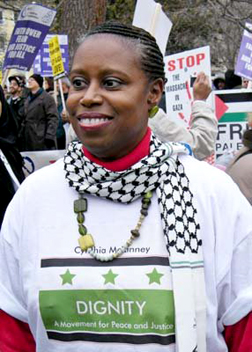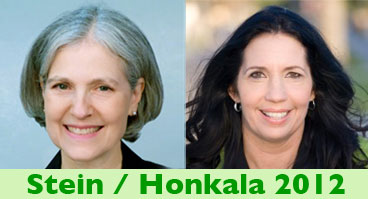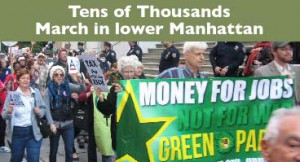Is the Green Party evolving through its presidential campaign?
Share

An editorial by David McCorquodale, Green Party of Delaware
I have been stunned by the strength and successes of the Stein-Honkala ticket! Regardless of the electoral outcome, make no mistake about it: this campaign is an improvement over our past presidential campaigns.
Here’s a brief review. In 1996 and 2000 Ralph Nader was the party’s standard-bearer. At neither time was Nader chosen through a primary process. Rather, he was an endorsed candidate. His candidacy showed both the benefits and the limitations of a campaign centered on an almost mythical personality figure. While he could personally draw in millions in contributions, the commitment was more to him than the party.
The focus of the current campaign is clearly about building the party and has largely taken over the ballot access duties from the national party.
When Nader decided to forego primary campaigning in 2004, instead hoping for another endorsement, even though he wasn’t a registered Green, the Party nominated an actual Green, David Cobb. When Nader formed his own independent campaign, the contributions left with him. The Cobb-Lamarche campaign was run on a shoestring-budget, but I understood that a number of state Green Parties would lose ballot access if we did not put up an actual Green as a candidate. Contrary to the accusations that the campaign would only go into “safe states,” the real limitation was that the candidates could only campaign when a state party could raise the money for transportation and come up with a place for a candidate to sleep.
When former six-term Congresswoman Cynthia McKinney of Georgia began to participate in Green state party primary debates for the nomination in 2008, there was justifiable excitement. Someone who had actually been elected to the highest legislative body in the country was running for the Green Party. During the now expanding primary and debate season, it was clear that the other candidates knew McKinney would be the nominee. However, after the McKinney-Clemente ticket was formed in Chicago, things started to unravel. The campaign obviously expected much greater support from the party. The party members expected a much stronger campaign organization. Neither side could deliver.
Between 2008 and the beginning of 2012, numerous state party organizations got even weaker. That weakness was reflected in the lower numbers of active participants in the National Committee and other GPUS committees, which had gone dormant for lack of members. Who would want to run a presidential campaign in such a situation? How could it possibly work?
I don’t know the inner details, but into the breach stepped the pairing of Dr. Jill Stein as candidate and Ben Manski as campaign manager. Dr. Stein had taken her activism on health issues to a higher level when she ran for Governor of Massachusetts in 2002 (against Mitt Romney). By all accounts she presented herself as the best candidate in that race. Since then Stein has run in several other Massachusetts races and was twice an elected representative of the town meeting of Lexington. Seasoned through a half dozen campaigns, the former singer in a folk band knows how to address a crowd and to focus discussion on the issues.
Ben Manski, though young compared to the typical nationally involved Green, has a long history of participation in the party. An attorney and the editor of Liberty Tree Journal, Manski has been both a candidate (for state assembly in 2010), a member of the Steering Committee of GPUS, and involved in fundraising as Chair of the Coordinated Campaign Committee of GPUS. I believe Manski saw the strengths and weaknesses of the national party and formulated a vision of what a presidential campaign had to accomplish in order to move the Green Party forward.
From its’ beginning the Stein campaign began to seek out Occupy groups to address. With the addition of Cheri Honkala, long-time advocate for the homeless and of those who are in danger of losing their homes to foreclosure, as the vice-presidential candidate the identification of the campaign with the dispossessed has become even stronger. This is changing the stereotypical view that Greens are only concerned about the environment. In formulating the plan for a Green New Deal, the campaign has created a ready set of discussion points which can help to change the focus of any debate toward our vision that all issues are interconnected and of the proper role of government in implementing such a vision.
Early in 2012, with Greens viewing Stein as a viable candidate and with a constantly updated campaign website, contributions started to flow. Already the campaign has achieved a historic first for a nominated Green presidential candidate of raising enough money ($5,000) in enough states (20) during primary season to receive federal matching funds. The campaign may not reach the level of money that Nader could raise, but it will certainly outpace the last two Green presidential campaigns’ fundraising.
Once it became clear that Stein would win the nomination, something remarkable happened! The campaign began to assume a role that we might expect the National Party to fill, but which it currently can’t do for lack of money and volunteers. It began to lead efforts to secure ballot access in various states, starting with Illinois, which was a huge task, but was accomplished. After the presidential convention, focus shifted to other states and ballot lines were secured in Pennsylvania, Maryland, New Jersey, Oregon, Kansas, Iowa, Washington and Wisconsin. The ticket will be on the ballot in at least 34 states (as of mid-August) and continues to work.
So what is going on here? I believe we are seeing the evolution of the way the Green Party must operate in order to move forward. The presidential campaign, being the only electoral campaign of the national party, must have a bigger role in that process. The focus of the current campaign is clearly about building the party and has largely taken over the ballot access duties from the national party. People are not easily motivated to give money to support abstract principles and ideals. There is an apparent need to provide faces and personalities as the literal embodiments of those ideas. It takes special people to step into such a role without being caught up in ego. The Stein-Honkala campaign has raised the bar and shown us where we must start to continue growing as a party.
David McCorquodale is Treasurer of the Green Party of Delaware, and co-chair of Green Pages.







